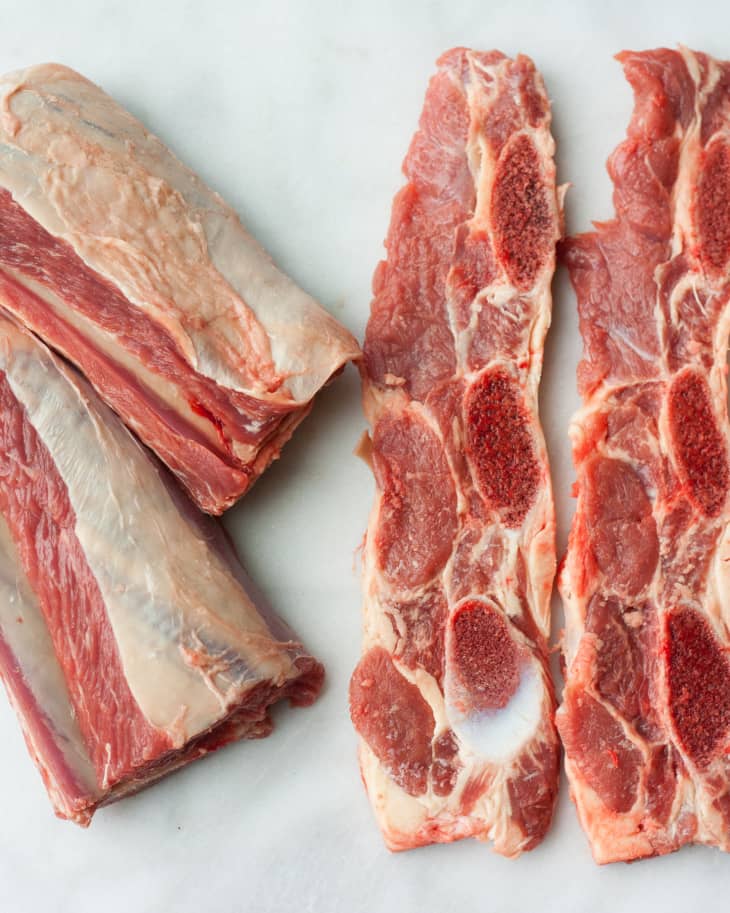What’s the Difference Between Flanken and English Cut Short Ribs?
Although short ribs used to be seen as a less desirable cut of beef, they’ve risen in popularity, causing prices to also increase for this cut that used to be fairly inexpensive. So if you’re now spending more for short ribs, it makes sense to get to know the two popular ways that they’re cut, flanken and English style.
The difference can come down to thickness of the cut and cook time for your desired meal. Once you know the differences in appearance and how they should be cooked, you can buy the right cut for your recipe!
Where All Short Ribs Come From
All short ribs are from a rib section that contains three to four ribs. Depending on where it is cut from, it can be three to five inches thick, and contains meat interspersed with a lot of muscle, fat, and tendon, which give it a lot of strong beefy flavor. Cooked properly, this cut can be very tender and juicy.
How the short ribs are then cut to be sold falls into two categories, flanken or English.
Flanken
In the flanken style of short rib, this thin cut, which is about 1/2-inch thick, goes across the bones so that each slice contains a few pieces of bone. This is a popular way to cut the short ribs if you’re going for a Korean barbecue kalbi-style result. Unless you’re shopping at an Asian grocery store, you most likely have to ask your butcher to cut these to order for you.
English Cut
The English style of short rib cuts between the ribs to separate them, leaving a thick piece of meat sitting on top of one piece of bone. These ribs can be left as is in one long piece or cut into smaller, approximately 2-inch long pieces. Boneless short ribs can sometimes be found, which mean that the meat is cut off the bones of an English-cut short rib.
Keep in mind that sometimes a short rib can be cut with a hybrid of the English and flanken styles. As you can see in the picture above, the short rib is cut against the bones like the flanken style but is cut into thick, English-style pieces. Since the thickness of the cut is really what matters, cook these thick pieces like English-cut short ribs.
Shopping for Short Ribs
If you need English-cut short ribs, try to get thick pieces, as thinner pieces tend to have a higher ratio of fat to meat. For flanken-cut short ribs, make sure the pieces are evenly cut and not ragged or torn apart at the edges. Check for small bone fragments before cooking.
If your recipe doesn’t specify which cut to get, take a look at the instructions. If it calls for a long cooking time, go with English-cut, but if it’s cooked quickly over high heat, go with the flanken cut.
Cooking Short Ribs
When cooking short ribs, you have two options, slow and low or fast and hot:
- Slow and low. English-cut bone-in or boneless short ribs are typically braised to extract the collagen to yield tender, juicy meat. Sear the outside to start to create deep flavors, then braise in flavorful liquid and aromatics until the meat is soft and flavorful from absorbing all the braising liquid, which will take a few hours over low heat. Braised short ribs taste even better the next day, so braise the day before, let them cool in the liquid, skim off excess fat after it solidifies at the top, and reheat before serving.
- Fast and hot. The flanken style of short rib needs to be cooked quickly over high heat, so broil or grill this cut. It can easily overcook and turn dry and tough, so keep a close eye on it, especially since the high fat content can cause flare-ups. Surprisingly, English-cut short ribs can also be cooked over high heat like a steak, and I’ve done it successfully on several occasions. It’s not as tender as a regular steak and can have big chunks of fat, but it still has great beefy flavor.
